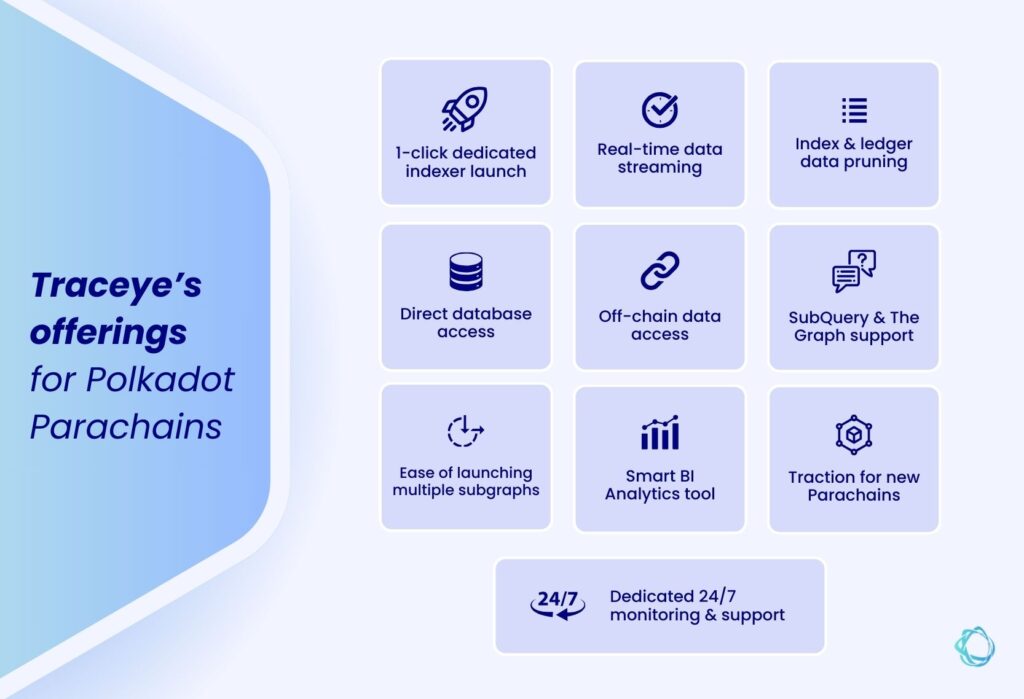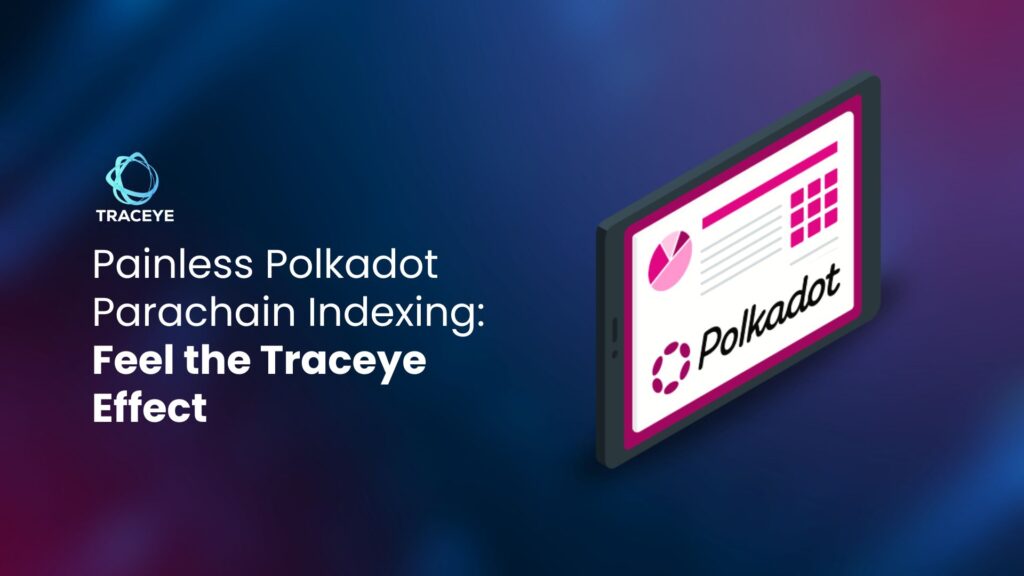Traceye is expanding its support to offer seamless Polkadot Parachain indexing. This is a major addition to Traceye’s existing rollup-specific data indexing offerings for OP Stack chain, Polygon CDK, Arbitrum Orbit, and ZK Sync chains indexing. Various types of Parachains can now use Traceye as their custom data indexing solution to leverage efficient data access, optimized data sorting, and consistent performance.
In this article, we’ll dive deeper into Traceye’s specific offerings for Parachains and highlight how it stands out as a preferred data indexing solution for today’s rollups & appchains.
Web3 Data indexers and their vital role in Polkadot Parachains
Web3 data indexers are solutions that make on-chain data query and retrieval easy for decentralized applications and data consumers. Whether it’s about the data historically synced into databases or the real-time information, data indexers are designed to ensure seamless access on each query. Speaking about Polkadot Parachains, data indexers handle indexing for the following chains:
- Permissioned Parachains: Use-case specific Parachains designed to work within a restricted, fully-permissioned ecosystem, can launch their own dedicated data indexer and use it to index data within their network, keeping the privacy and accessibilities parameters intact.
- Permissionless Parachains: Parachains with permissionless design can either use a dedicated indexer to use within their network or they can launch multiple subgraphs on top of the indexer to offer for their community.
What makes Traceye an ideal data indexing solution for Parachains?
Traceye serves as an ultimate data indexing solution for diverse Polkadot Parachains, be it permissioned or permissionless. Below are the top features that Traceye offers under the hood:
1-click dedicated indexer launch:
Traceye has simplified the end-to-end process of launching a data indexer node. From node deployment to integration of advanced add-ons, and 24/7 monitoring system’s setup, each step is now just a click away. Traceye saves you from the hassle of writing lengthy codes, doing configuration, and adding integrations, Polkadot Parachains can now use a low-code tool to launch their personalized indexer within a few minutes.
Real-time data streaming:
Traceye offers webhooks as add-ons service that projects can use to retrieve live on-chain data while also simultaneously querying data from the indexed databases. Let’s say you have a Parachain dedicated to DeFi trading; it will need both indexed data and real-time information such as smart contract data, settlement details, liquidity, asset ownership, and a lot more. Webhooks will provide all these data to the Parachain without any heavy lifting. Note that webhooks are offered as an add-on with Traceye that you can subscribe to while opting for the dedicated indexer or even the shared subgraphs.
Index & ledger data pruning:
Data pruning is one of Traceye’s novel methods to optimize query & database and thereby ensure the top-notch performance of Graph node and also for the subgraphs deployed on its top. Index and ledger data pruning are the two methods that Traceye currently supports. Both of these allow you to retain data for your desired block count and automatically prune older data. However, the difference is that index data will prune data from a network’s metadata, whereas ledger data pruning is handled through subgraphs using cron.
Smart BI Analytics tool:
The BI analytics tool is another valuable add-on offered on Traceye. This is essentially an interactive dashboard that breaks down complex blockchain data into engaging information presented through tables, graphs, and charts. In a few simple steps, you can gather insightful analytics using the data from your subgraphs spanning Gaming, DeFi, NFTs, or cryptos.
Direct database access:
Traceye features ‘Elastic search’ or ‘custom search’ that allows Parachain networks to query data directly from the indexed databases without requiring them to run GraphQL queries via subgraphs. Additionally, Traceye provides you the flexibility to combine both the GraphQL APIs and Elastic search to perform high-level data indexing.
Off-chain data access:
Polkadot Parachains and all other chains need hands-on access to off-chain or real-world data. However, this whole process can be a little complex and time-consuming. Considering this, Traceye offers ‘Custom Entities’ that seamlessly retrieve data from off-chain databases and provide it through Graph nodes. Also, you can combine both the on-chain and off-chain data to utilize for application-specific needs. For example, you can query data quickly from a Web2-based DeFi exchange using Traceye’s custom entities.
SubQuery and The Graph support:
Designed as a universal data indexing solution, Traceye supports almost all the leading data indexing protocols, including the popular ones like SubQuery and The Graph Network. You might already know that SubQuery was originally designed for Polkadot Parachains, and later, it opened up for diverse networks. Well, that’s just for your information. Coming to the projects, they can set up their data indexer with such popular protocols using Traceye’s low-code tool to instantly launch their node, query data, and manage it efficiently. And, if we talk about blockchain networks, Traceye is aligned with a range of networks that are not yet available on SubQuery and The Graph protocol.
Multiple subgraph launch:
Node infrastructure on Traceye is optimized to support launch of multiple use case-specific subgraphs. For example, your Graph or Subquery node can be used to set up distinct subgraphs powering gaming, NFTs, DeFi, or tokenization. As required, you can retrieve specific data from each of these subgraphs. Rest assured, Traceye ensures top-grade performance and availability for all the subgraphs and the indexer node.
Traction for new Parachains:
There’s a provision on Traceye where permissionless Parachains, which are new, can utilize the shared subgraph infrastructure. This will allow developers and data consumers to index their Parachain data, and thus drive traction to the network. So far, this option is a cost-effective and simple way of building community for a rising Parachain.
Dedicated 24/7 monitoring & support:
Apart from offering indexer node-as–a-service, Traceye also takes accountability for maintaining the optimal performance of indexers and shared subgraphs. For this, Traceye offers a 24/7 dedicated monitoring system that keeps track of hardware and software performance parameters like disk usage, memory consumption, CPU performance, RAM, storage, etc, while also displaying real-time status on a graphical dashboard. If issues are detected, the dashboard produces alerts, which are then solved automatically through Traceye’s intelligent dashboard.

Benefits of using Traceye for your Polkadot Parachain indexing
Now that we are aware of Traceye’s comprehensive features and offerings, let’s quickly see its main benefits:
- Ultra-fast data indexing: Traceye offers blazing-fast response to all your data queries with amazing 5X data backfill technique.
- Saving significant cost: Launching, managing, and scaling your indexer node is cost-efficient on Traceye. That’s because you do not need to get subscriptions separately for each service, a single plan is all you need.
- Multiple subgraphs: A dedicated indexer node on Traceye can power launch of multiple custom subgraphs on its top.
- Uptime & 100% availability: Traceye offers 100% availability and uptime for your indexer node with 24/7 Enterprise SLA and dedicated infrastructure monitoring.
- Powerful add-ons: Add-ons services that Traceye offers are highly feasible. This includes webhooks, the BI analytics tool, Index data pruning, and ledger data pruning. These add-ons are available at a minimal cost, and you can opt to power up the performance of your data indexer.
Ready to Launch your data indexer? Do it yourself on Traceye!
Traceye’s features that we discussed in this article is a snapshot of its comprehensive offerings. Note that the dedicated indexer service on Traceye is production-ready and is available for diverse Polkadot Parachain indexing. Any Paracain project looking for a powerful data indexing solution can set up their indexer node on their own with Traceye’s low-code node deployment tool and enable critical add-ons. Further for performance, they can leverage the 24/7 monitoring dashboard and hands-on support from Traceye’s team. Connect with our experts if you have further queries or you want more information about Traceye’s service.

Product Director & an intrapreneur with a focus on intersection of technology and business models. Having 10+ years of experience in consulting, software design & architecture, product and project management. Career track follows working on ERPs, Consumer & Enterprise products, stints in AI & Machine Learning and finally settling in decentralization & Blockchain space.
